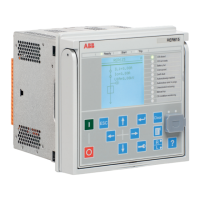the voltage of the faulty phase decreases and the corresponding capacitance is
discharged to earth (→ discharge transients). At the same time, the voltages of
the healthy phases increase and the related capacitances are charged (→ charge
transient).
If the fault is permanent (non-transient) in nature, only the initial fault transient
in current and voltage can be measured, whereas the intermittent fault creates
repetitive transients.
Figure 163: Example of earth-fault transients, including discharge and charge
transient components, when a permanent fault occurs in a 20 kV network in phase C
4.2.3.6 Signals
Table 370: INTRPTEF Input signals
Name Type Default Description
Io SIGNAL 0 Residual current
Uo SIGNAL 0 Residual voltage
BLOCK BOOLEAN 0=False Block signal for acti-
vating the blocking
mode
Table 371: INTRPTEF Output signals
Name Type Description
OPERATE BOOLEAN Operate
START BOOLEAN Start
BLK_EF BOOLEAN Block signal for EF to indicate
opposite direction peaks
4.2.3.7 Settings
1MRS758755 C
Protection functions
REC615 & RER615
Technical Manual
339

